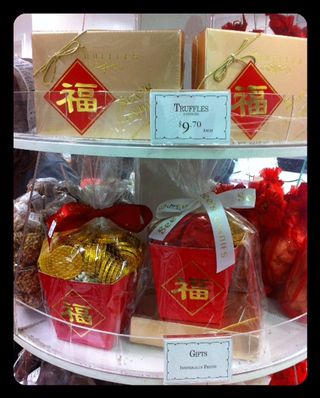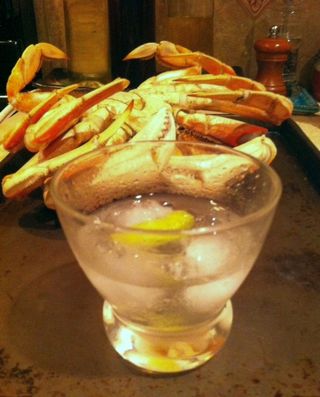I am a low meat eater and wouldn't venture to be a complete vegetarian – though the Chinese New Year candy display at See’s (photo above) may convince me. In fact, tonight on the Tet Eve, I am cooking a crab and will use its meat for a cellophane noodle and crab dish tomorrow; the gin and creme de menthe on the rocks (a "Double Dragon") was the meatless part. I’m saying that I’m not going meatless for Tet tomorrow.
However, my friend Simon Bao has been contemplating how he and his partner will celebrate the Year of the Dragon without any ingredients from legged or finned animals. Vietnamese Buddhists who adhere to a strict vegetarian diet will be enjoying a vegetarian Tet menu. During Tet, it’s not good to take the life of another being, according to tradition. (For other Tet dos and don’ts, see this 2011 post from the People’s Army Newspaper in Hanoi; you know that it has to be officially sanctioned.)
This evening, Simon sent this message to relay what they’ll be eating tomorrow. My comments are in [brackets.] One of the cool things in Simon’s menu is how he thinks about delivering the savory umami-ness in foods. That’s among the flavors that make us feel satisfied during a meal. Simon’s meatless Tet menu:
Andrea, it's a White Tet here [on the East Coast], white because there is snow on the ground. Only a few inches, just enough to make it very much unlike Tet. 🙂
We WILL be eating a Meatless Monday Tet dinner tomorrow, and here's what I intend.
We like have an appetizer to start on before we sit down in the dining room, something to eat while hanging around in the kitchen and finishing up the cooking. Given the absence of meat from the menu, I thought that a deep-fried appetizer was necessary as compensation. So we will have Cha Gio Chay, fried vegetarian spring [imperial] rolls, the usual way [usually taro is involved for a buttery quality], wrapped in lettuce leaves, and dipped in Nuoc Cham. [Here’s a recipe from Wandering Chopsticks that he’ll be riffing off of.]
They were not my first choice; my first choice was Cha Gio Bap [the fried rolls above made with corn], also vegetarian, but filled with sweet corn. Problem was, I decided to go with your own corn soup as our starter, Sup Bap Nam Huong [see Into the Vietnamese Kitchen, page 74] (Corn is the only grain that has even a trace of umami savoriness.)
There seem to be almost no Vietnamese soups that are genuinely meatless, almost all have some seafood or pork or fowl or other animal protein in them. And those that are authentically meatless tend to be sorrowful and disheartening. But the corn soup with the shiitakes (umami!) works pretty well. [I totally agree. It’s sweet, savory, and silky.]
For the main dishes, we will have bowls of 50/50 rice (half brown rice/half white rice, simply steamed) plus the following:
Kohlrabi, Julienned & Stir-fried with Garlic & Egg (brassica veggie, some protein, umami!) [see my recipe here]
Tofu Braised with Tomatoes & Onions (protein, sweetness & acidity, more umami!)
Pea Tendrils, Spinach & Watercress Stir-fried with Garlic & Ginger (necessary non-brassy greens, both sweet and peppery)
Braised Mushrooms & Vegetables with Oyster Sauce: sliced portabella, crimini mushrooms, snow peas, carrots, scallions, peppers, asparagus, Chinese broccoli (mushrooms & oyster sauce = umami, plus more veggies) [Here is where Viet vegetarianism falters just a bit – you can have oyster sauce and fish sauce, if you’re not a hardcore Buddhist vegetarian. I hope Simon cooks with regular oyster sauce because the vegetarian alternatives are not great, IMHO.]
Wine: I have no idea how a wine steward would pair wine with such foods - frankly I think a low-cost Sauvignon Blanc or Chenin Blanc would probably be just fine if that's what's on hand - but we will drink the leftovers from today's party, and that's Riesling, Viognier, and Gewurtztraminer, and those are all very fine.[A Torrontes would work well too!]
Dessert: We will have a simple version of Che Chai Cay, omitting any syrup. No cans of fruit, though. I'll cut some supremes of red grapefruit and navel oranges, mix that with some pineapple, sliced bananas, peeled and sliced persimmons, and dress it with a bit of Orange-Pineapple-Banana juice and some Grand Marnier. And probably munch on some Mut [candied sweetmeats, a Tet must-have] as well.
So... would such a meatless meal at Tet send your parents into despair? Would elderly maiden aunts clutch at their pearls when facing such plates? Would young nephews storm out and head to Burger Land? Or would it be tolerable, knowing that next year Tet will surely not fall on a Monday again, and there's pork and chicken waiting to be eaten tomorrow?
Nah, my folks have lived for too long under too many circumstances to do into a downward state of despair. They respect people for their dietary convictions. They also don’t eat much meat as they watch their weight and cholesterol, now that they’re in their 70s and 80s.
My thinking is that we’ll celebrate many more Tet in the future. Going meatless once every 7 years is a worthwhile endeavor. I’m willing to give it a go but not this year. Cheers to Simon for sticking to his guns.
Your thoughts? How would you construct a meatless Tet or Chinese New Year?
Tet can be celebrated for the next 1 week or so. If you need to brush up, some posts to browse:
Related posts
- Enter the Dragon: Fun Lunar New Year (Tet) Sweets, Cards & Decor
- Simple Ways to Celebrate Tet: Easy, no-sweat things to do for Tet, such as a downloadable Tet couplet for your door, pointers on how to wish people “Happy New Year” in Vietnamese, Cantonese and Mandarin, and how to attract good luck for the New Year (xong dat)
- How to find a Tet Festival: Tips for locating these events, which hare typically advertised only in the Vietnamese community!
- Traditional Tet Flowers and Blossoms: My father used to cut blooming branches from trees he found in the neighborhood. You can clip like him, or buy, like me. This post tells you what to look for. Learn about the flowers for the holiday.
Food
- Lucky Chinese New Year Dumplings
- Special Foods for Tet Celebrations: What is typically eaten during this holiday? Great for menu planning.
- Banh Chung and Banh Tet: What are they and how do you eat these sticky rice cakes
- Pan-fried Tet Sticky Rice Cake Recipe (Banh Chung Chien)
- Chicken and Bamboo Shoot Noodle Soup Recipe (Bun Mang Ga)
- Download step-by-step photos of how to form and wrap banh chung Tet sticky rice cakes . The mold is my preferred method because it's much easier to get the square shape, a hallmark of the sticky rice cakes. The photos correspond to my detailed recipe for banh chung in Into the Vietnamese Kitchen (Ten Speed Press, 2006).
- Banh Chung Tet Sticky Rice Cake Recipe
- Candied Lotus Seeds Recipe
- Chinese peanut cookies




















SimonBao says
Andrea, I'll be cooking dinner tonight using ordinary, Non-Vegan oyster sauce and fish sauce. We're not eating meatless tonight as any kind of Buddhists or vegetarians, but simply because we usually do Meatless Mondays. And it is a bit of a challenge to come up with savory, meatless courses that might still satisfy as a Tet meal.
I considered signing up with the Buddhists, but they apparently run background checks these days, and they left word that I should try elsewhere. 🙂
Andrea Nguyen says
Simon, thanks for sharing your menu for Tet! A little fish sauce and regular oyster sauce is a-okay with me, and flexible Buddhists too, I imagine. They'd happily eat your dinner if you presented it to them. Don't ask, don't tell.
Max Criden says
Hi Andrea!
"Braised Mushrooms & Vegetables with Oyster Sauce: sliced portabella, crimini mushrooms, snow peas, carrots, scallions, peppers, asparagus, Chinese broccoli (mushrooms & oyster sauce = umami, plus more veggies) [Here is where Viet vegetarianism falters just a bit – you can have oyster sauce and fish sauce, if you’re not a hardcore Buddhist vegetarian. I hope Simon cooks with regular oyster sauce because the vegetarian alternatives are not great, IMHO.]"
This brought up an interesting question for me that I was going to email you and ask you about, but this seems as good a place as any to ask. My wife and I love Vietnamese and Thai cuisines, both of which use a hearty helping of fish sauce. We also like cookery involving Oyster Sauce. Recently, though, inspired by reading Eating Animals (a terrific book if you have not yet read it), we have become vegetarians. This has put us at a real loss when it comes to our homemade bun, banh mi, Thai fried rice, and a plethora of other dishes that are part of our typical repertoire. I was wondering if, since your last post on the subject that I recall seeing was quite a while ago, you have discovered any more substitutes for fish sauce in particular, or work-arounds for it. Thank you!
P.S. Still have not taken that trip to Vietnam yet! But your post and question to your readers that you so graciously made last year will surely be a boon to us when we do so.
Andrea Nguyen says
Max, Simon does use regular oyster sauce -- thank goodness. I totally agree with you about the vegetarian alternatives.
As for vegetarian workarounds for fish sauce, I've not found a great substitute. You could use light (regular) soy sauce in lieu of fish sauce for dipping sauces, but compensate with salt, or the soy sauce may turn the dipping sauce too dark. That is, don't use the same amount of soy sauce as you would fish sauce. Thai Buddhists tend to be flexible when it comes to condiments. A little fish sauce or oyster sauce does not lessen their religious devotion.
cooking grill says
Nice. I love all your recipe..:)
Mr. Cooking Grill says
this must be appreciated by all!
marlon says
i really appreciate your recipe!
Nickle says
very good post for every one! nice one 🙂